Coral Reef
The coral reef is the most perse ecosystem in the ocean, and one of the most perse ones in the world. Coral reefs take up less than 1% of the oceans’ total area but contain 25% of marine creatures [1] - a number so large that we often compare them to tropical forests under the sea.

1. What are Corals and Coral reefs?
What are corals?
Corals are marine creatures in the form of small polyps, often in groups of identical inpiduals. Polyps belong to the Cnidaria phylum, which contain sea anemones and jellyfish. Imagine coral polyps as a food can, that when opened, has a ring of tentacles surrounding the top. These tentacles have nematocysts to help the coral polyps catch surrounding planktons.[2] Unlike sea anemones, corals can produce calcium carbonate to form skeletons. Most corals develop best in warm, shallow, clean and flowing water, with a lot of contact with sunlight.
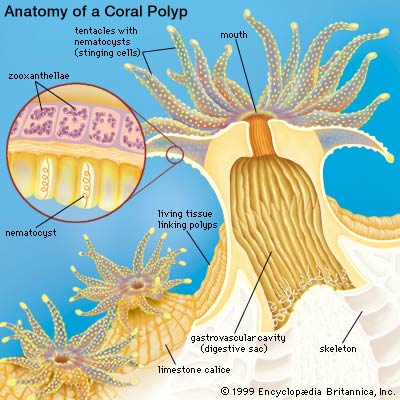
The texture of a coral polyp. From Encyclopedia Britannica.
Except for the fire corals, all corals can be categorized into two subclasses: hard corals (including brain corals and staghorn corals) - that have skeletons made of calcium carbonate, and considered the main components of a coral reef; and soft corals - that have no skeletons, and are so soft that they sway with the ocean currents. Hard corals leave their white, red or black skeletons when they die. Soft corals leave nothing.
Corals exist in many shapes. Hard corals, for example, can look like brains (brain corals), stars, tree branches (Acropora), disks, some soft corals include sea fan corals, sea pens (that look like quills),
Pictures of some of the most common types of coral
How do corals grow?
Corals grow and develop by using tentacles to catch floating planktons and nutritious debris.
Corals live in shallow water has a unique symbiotic relationship with single-celled dinoflagellates called Zooxanthellae. These single-celled dinoflagellates photosynthesize and provide food for coral polyps, while coral polyps help digesting food and expel nutrition to feed the dinoflagellates. These symbiotic relationships help corals grow well in shallow sea areas.
Corals can reproduce sexually or asexually!
With the asexual reproduction method, once coral polyps reach a certain size, they pide themselves and create a genetic clone. Corals do this their entire life. Asexual reproduction help increase the area of coral reefs.
With the sexual reproduction method, corals’ eggs are fertilized by sperms, creating larvae swimming freely in the water. The larvae then settle in an appropriate environment and grow into baby corals. Sexual reproduction helps persity the gene pool and creates new coral reefs.
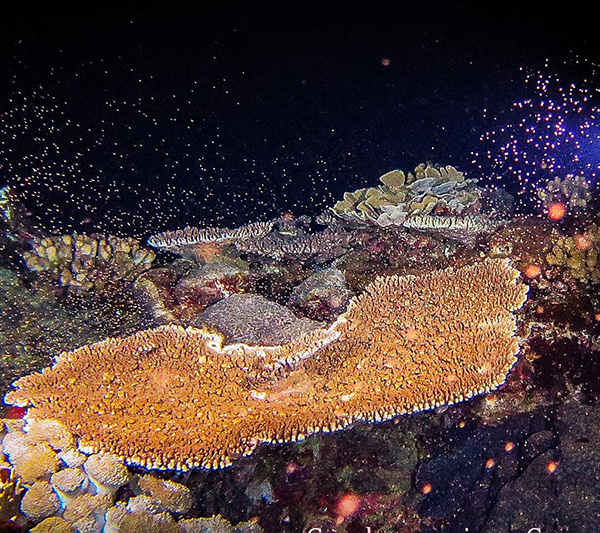
From corals to coral reefs
Coral polyps are miniscule. However, they grow by developing their basal plates vertically, sometimes partitioning to create even higher new plates. Over many generations, this growth creates large groups of corals. Coral reefs consist of many such groups, plus other creatures whose body structures contain calcium carbonate like corals. The largest coral group in the world is the Great Barrier in Australia, about 2600 kilometers in length, so big that it can be seen from spaceships!
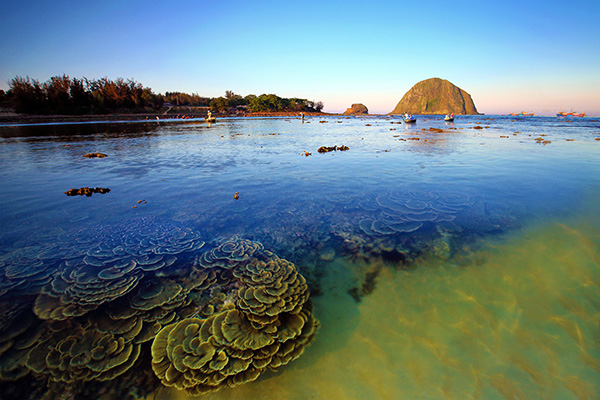
Coral Reef in Vietnam. Photo taken by Huynh Le Vien Duy from the contest "One Ocean, One Future" (U.S. Embassy, 2016)
Corals can be found in tropical and temperate oceans, but coral reefs only form in areas that lie in the equator between latitude 30° north to 30° south. Corals that form reefs don’t live anywhere deeper than 46 meters and under 20°C in temperature.
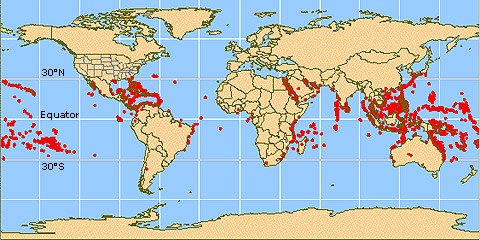
Coral distribution in the world. Photo: NOAA
Coral reefs are like miniature cities for marine creatures. Under the sea, coral reefs provide shelter and food for about 4000 species of fish, 800 species of corals and hundreds of other marine creatures.
Coral reefs are one of Vietnam’s unique marine ecosystems, with extremely high biological persity and amazing scenery. Coral reefs in Vietnam are scattered from the North to the South with a total area of over 1100km2[3] , with the highest area and biological persity in the central and Southern seas.
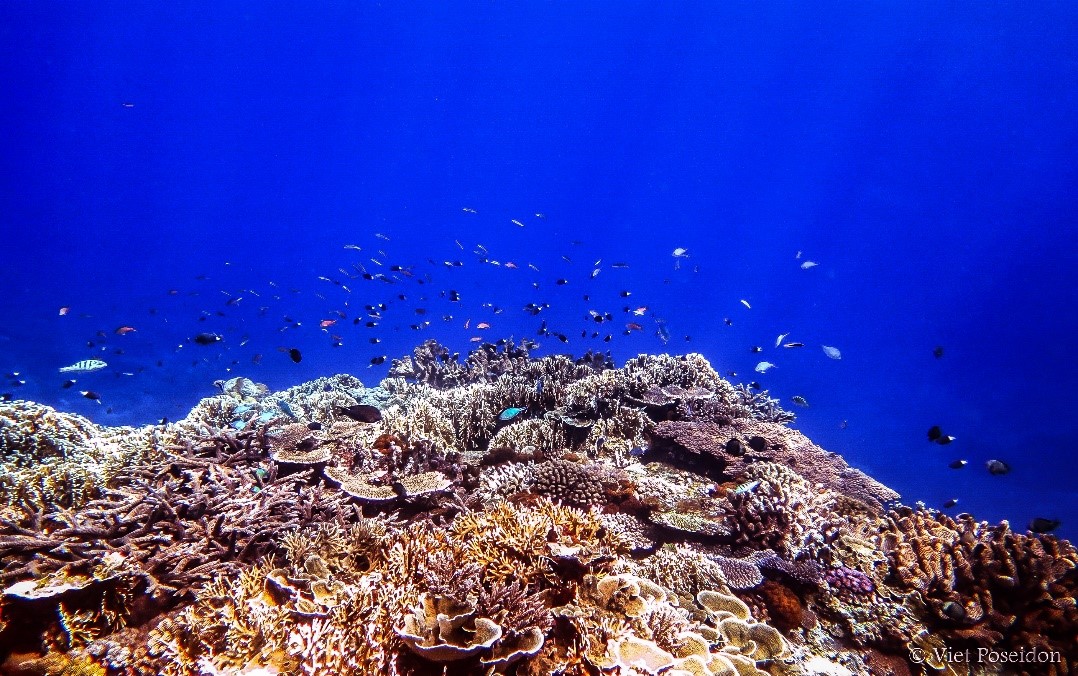
A typical coral reef. Photo: Đặng Đỗ Hùng Việt
Corals in Vietnam are very perse, with about 400 species of hard corals, belonging to 79 genera. The coral population in Vietnam can be compared with the most perse coral populations in the world.[4]
Furthermore, according to recent scientific researches in Vietnam, the total number of marine creatures found in coral reefs are about 3000 species, most of which are coral fish (615 species), followed by corals (444 species); molluscs (410 species); seaweed (376 species); phytoplanktons (310 species); zooplanktons (187 species); Echinoderms (116 species); Crustaceans (92 species); mangroves (61 species); polychaetes (43 species); seagrass (11 species).[5]
In many cases, coral reefs act as a shield to protect beaches from inundation. These shields also reduce the force of ocean waves, helping to protect the land and water behind the coral reefs during storms.
During April and May of 2016, coral reefs are the most affected ecosystems in the ocean. 100% of coral reefs in surveyed areas show signs of bleaching; some coral group died. The most affected areas are the coral reefs in: Hon Son Duong – Ha Tinh (90% coral loss), Hon Nom – Quang Binh and Hai Van, Son Cha – Thua Thien Hue (the rate of coral decline is 66.7%) [6]
2. Coral reefs are disappearing!
According to some researches, about 70% of coral reefs all over the world are endangered. A great area of global coral reefs have disappeared (about 27% according to NASA) only in the last 50 years.[7]
The phenomenon of bleaching corals is also rapidly happening. This phenomenon was unknown until the 1980s, when vast populations of bleached corals appeared, mainly in the tropical areas in Eastern Pacific Ocean and Caribbean Sea. In the last 25 years, the rising temperature has accelerated the bleaching and destroyed coral reefs. The ocean’s temperature increased dramatically in 1998 and 2005 and left many coral reefs dead, with little chance of recovering. Scientists’ assessment shows that coral bleaching has destroyed the majority of coral reefs globally. Research also shows that only well-protected coral reefs have a chance of recovering.[8]
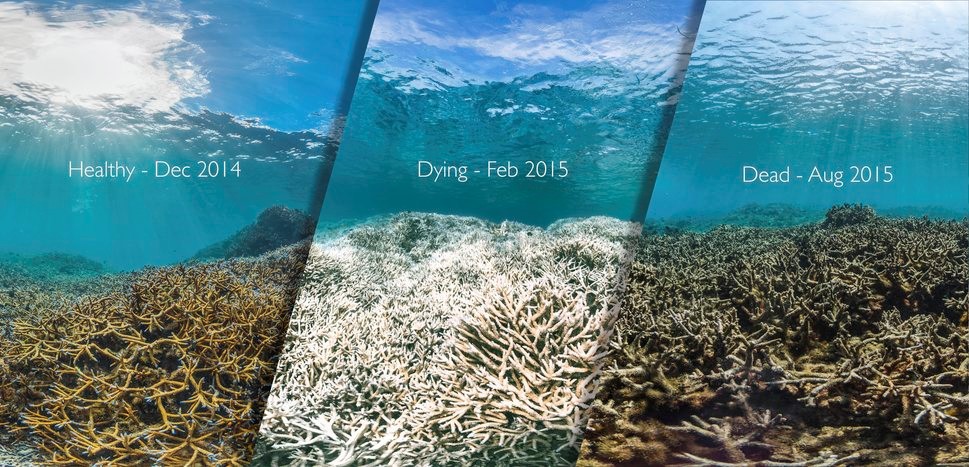
Coral reef in Samoa in different stage: Healthy - Dying - Dead. Photo: XL Caitlin - Seaview survey.[9]
Along with the deterioration of coral reefs is the disappearance of rare marine species. In Vietnam, there are 36 species belonging to the coral reef ecosystem listed as Endangered in the Red List of Vietnam: coral reef fishes (9 species), hard corals (11 species), bottom feeders (10 species), seaweed (5 species) and mangroves (1 species).[10]
3. Why is this happening?
Overall, the coral ecosystem is extremely complex and sensitive to environmental threats.
When corals are small, they are easy preys for many marine creatures. Once they have developed skeletons, they’re no longer often preys; however there are still some fish, polychaete worms and starfish that hunt mature corals. Especially, in many seas in the Pacific Ocean, the crown-of-thorns starfish excessively hunt corals. The explosive growth in the population of the crown-of-thorns starfish can quickly cover and destroy an entire coral reef in less than a year. Many coral reefs in Central Vietnam have been affected by crown-of-thorns starfish in recent years, which lead to their significant dwindling.[11]
One of corals’ biggest threats is bleaching (the loss of pigments). This phenomenon happens when the temperature of the surface of the ocean rises, which impacts the zooxanthellea that lives in symbiosis with corals. The rise needs only be 1 to 2°C above normal to cause the bleaching.[12] Prolonged bleaching can kill coral populations or make them vulnerable to other threats. In recent years, many tropical coral reefs have been bleached or killed. However, recovery has been discovered in some far-off areas but climate change could reverse this recovery.
The acidification of the ocean - a rise in the acidity in seawater - also causes difficulty in corals’ process of forming calcium carbonate skeletons. If the acidification accelerates, existing bone structures in coral reefs could also be destroyed.[13]
Area and quality of corals and coral reefs have been and are significantly decreasing with the rise of activities on and near the sea. Recent researches show that coral reefs in many areas in Vietnam are worsening from both artificial and natural influences, most of which is coral harvesting, overfishing, tourism, dredging,...in seas with coral reefs.[14]
Even activities remote from coral reefs can have a big impact. Liquid waste from near the sea, cities and farms, can cause algae in the sea to grow too fast and overwhelm coral reefs. Deforestation causes land erosion, leading the water to carry soil into the ocean which then forms sediments over coral reefs.
4. Let’s act
Ocean reservations play an integral role in protecting corals, in which the most important element is fostering a healthy fish community and ensuring clean seawater for the growth of corals. Fish are essential to corals, especially those that eat seaweed and thus prevent it to overgrow corals, as well as carnivorous fish that keep crown-of-thorns starfish from coming near and eating corals. Coral areas strictly protected usually have healthier coral populations that stand a better chance at recovery after disasters. Therefore, please support ocean reservations and other coral reservation programs if possible!
Clean water is also very important to corals’ existence. Liquid waste from land enters the ocean through rivers and carries with it soil, nutrition that accelerates the growth rate of algae and creatures that feed on corals. Therefore, efficient land use, limited use of artificial fertilizer, and prevention of land erosion from deforestation and construction…also help to reduce sediment-rich soil to enter sea areas with corals. Each of us could contribute to keeping the water clean by limiting our water use and water waste.
However, in the long term, the future of coral reefs depends on the reduction of carbon dioxide (CO2) in the atmosphere. CO2 made from burning fossil fuels has made the ocean warmer, which leads to coral bleaching and the acidification of seawater. Each of us could limit our CO2 emission in many ways, such as conserving energy and using environmental-friendly products,
If you travel in sea areas with corals, you and your fellow travelers could help the coral population by:
- Refuse to partake in the trade of corals and coral fish
- Improve your diving skills. This will prevent you from touching things while underwater. One diver touching corals can cause negligible damage, but keep in mind that you are only one in the thousands of divers in that area in a year. You should not bring sticks or gloves. Not touching or trampling on corals while diving is also beneficial to them!

- Respect marine creatures that reside in the coral reef. Actions that may seem fun to us could actually cause great stress for marine creatures. For example, clown fishes (Nemo) are famous for being territorial. When a clown fish swims towards you, it means it is trying to protect their anemone bush where its family live. Sea turtles need to swim to the surface for air, but their panic response is to dive deep into the water. If they feel too threatened, they might not resurface. Our actions can have lasting consequences, even after we have left the water. Therefore, keep in mind that we are actually “uninvited guests” under the sea, and mind our behaviors. You should not touch, chase, or come too close to marine creatures.


